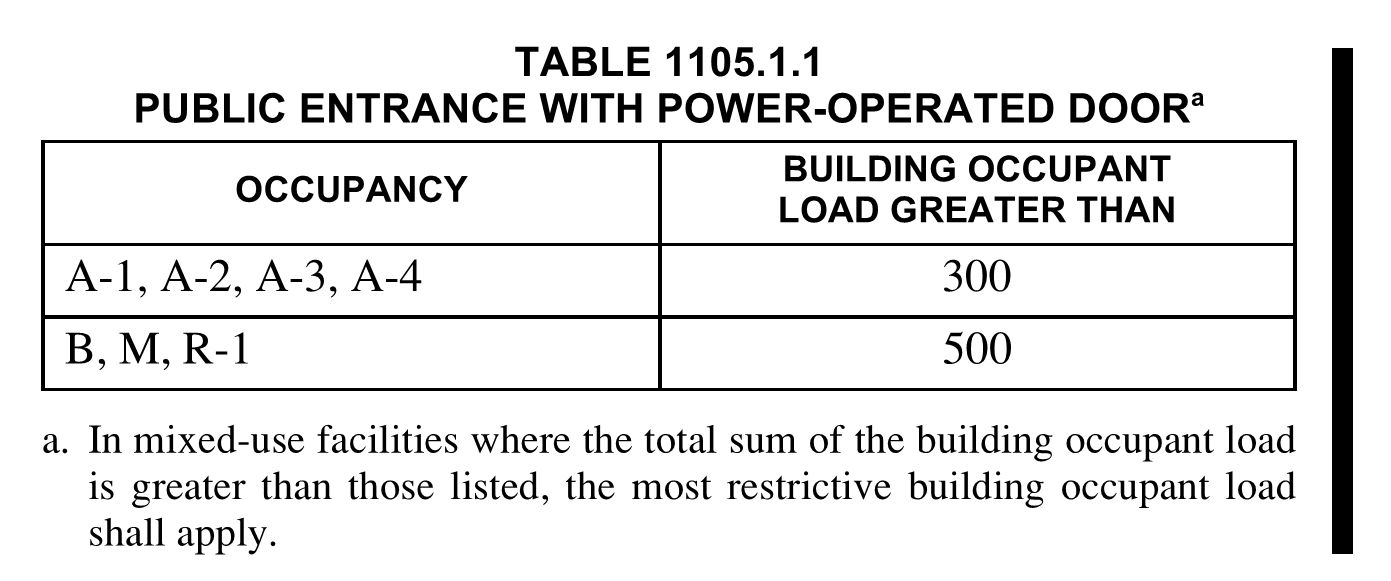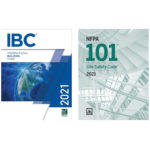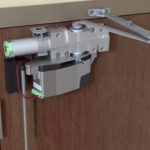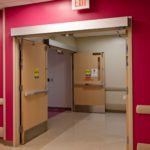I have combined several posts on this topic into one complete article – let me know if there are any other FAQs I should add.
This post was published in Door Security + Safety

 Until now, automatic doors have not been required by the model codes or referenced standards in specific locations within a building, although auto operators are often installed when a door can not meet the accessibility requirements for a manual door. For example, if a door does not have the mandated maneuvering clearance necessary for someone to open a door manually while using a wheelchair, adding an automatic operator could solve the problem because automatic doors do not require the same maneuvering clearance as manual doors.
Until now, automatic doors have not been required by the model codes or referenced standards in specific locations within a building, although auto operators are often installed when a door can not meet the accessibility requirements for a manual door. For example, if a door does not have the mandated maneuvering clearance necessary for someone to open a door manually while using a wheelchair, adding an automatic operator could solve the problem because automatic doors do not require the same maneuvering clearance as manual doors.
This will change with adoption of the 2021 edition of the International Building Code (IBC). The 2021 IBC states:
1105.1.1 Automatic doors. In facilities with the occupancies and building occupant loads indicated in Table 1105.1.1, public entrances that are required to be accessible shall have one door be either a full power-operated door or a low-energy power-operated door. Where the public entrance includes a vestibule, at least one door into and one door out of the vestibule shall meet the requirements of this section.
(Note that the solid black vertical line indicates a change from the previous edition of the code.)
The intent of this change is for buildings in certain use groups to have automatic operators on at least one door or one set of doors (exterior and vestibule) at each public entrance that is required to be accessible. The operators can be either full power operated or low energy power operated. A power-assist operator would not meet the requirements because it only reduces the opening force, it does not open the door automatically.
Here are a few FAQs about this code change:
What is considered a public entrance?
In the 2021 edition of the IBC, a public entrance is defined as “An entrance that is not a service entrance or a restricted entrance.” The requirements for these entrances are included in Section 1105 – Accessible Entrances.
Which public entrances are required to be accessible?
IBC Section 1105 requires at least 60 percent of all public entrances to be accessible. In addition, this section requires the following types of entrances to be accessible:
- Parking Structures – Where direct pedestrian access is provided from a parking garage to a building or facility, the entrances must be accessible.
- Tunnels and Elevated Walkways – Where direct pedestrian access is provided from a pedestrian tunnel or elevated walkway to a building or facility, at least one entrance from each tunnel or walkway must be accessible.
- Restricted Entrances – Where restricted entrances are provided to a building or facility, at least one restricted entrance must be accessible.
- Entrances for Inmates or Detainees – At judicial facilities, detention facilities, and correctional facilities, where entrances are used only by inmates or detainees and security personnel, at least one such entrances must be accessible.
- Service Entrances – When a service entrance is the only entrance to a building or tenant space, that entrance must be accessible. When a service entrance is not the only entrance to a tenant space, the service entrance is not required to be accessible.
- Tenant Spaces – At least one accessible entrance must be provided to each tenant space, except for self-storage facilities that are not required to be accessible.
- Dwelling Units and Sleeping Units – Each dwelling unit and sleeping unit in a facility must have at least one accessible entrance, except that an accessible entrance is not required for units that are not required to be Accessible units, Type A units, or Type B units.
If an area is not required to be accessible, an accessible entrance is not typically required. This means that areas that are exempt from the accessibility requirements are usually also exempt from the requirements for an accessible entrance. Refer to the applicable building code or accessibility standard to learn more about these exceptions.
In which types of buildings are accessible public entrances required to have at least one automatic door or one set of automatic doors (exterior and vestibule)?
The change applies to almost all types of assembly occupancies with an occupant load of 300 people or more, and for business, mercantile, and R-1 residential occupancies with an occupant load of 500 people or more. The examples listed with each use group below are not intended to be inclusive of every type of facility.
Occupant Load 300+
- A-1 – assembly occupancies, usually with fixed seating, used for production and viewing of the performing arts or movies, including movie theaters and other types of theaters, symphony and concert halls, and TV and radio studios that admit an audience
- A-2 – assembly occupancies used for food/drink consumption, including banquet halls, gaming areas of casinos, nightclubs, taverns, and bars, restaurants, cafeterias, and similar dining facilities (including associated commercial kitchens)
- A-3 – assembly occupancies used for worship, recreation, or amusement and other assembly uses not classified as another Group A use group, including arcades, art galleries, bowling alleys, community halls, courtrooms, dance halls (without food or drink consumption), funeral parlors, lecture halls, libraries, museums, places of religious worship, waiting areas in transportation terminals, and gymnasiums, indoor swimming pools, and indoor tennis courts without spectator seating
- A-4 – assembly occupancies used for viewing of indoor sporting events and activities with spectator seating, including arenas, skating rinks, swimming pools, and tennis courts
Note: Group A-5 is not included in the table that requires automatic operators at the accessible public entrances. This use group applies to assembly occupancies used for participation in or viewing outdoor activities, including amusement park structures, bleachers, grandstands, and stadiums (the auto operator requirement does not apply here).
Occupant Load 500+
- B – business occupancies used for office, professional, or service-type transactions, including ambulatory care facilities, doctors, dentists, and veterinarian offices, banks, beauty salons, outpatient clinics and ambulatory care facilities, labs, post offices, and educational occupancies for students above the 12th grade (colleges and universities)
- M – mercantile occupancies used for the display and sale of merchandise including merchandise stock, where the public has access, including retail stores and markets, greenhouses providing public access for the display and sale of plants, and motor-fuel dispensing facilities
- R-1 – residential occupancies containing sleeping units where the residents are primarily transient in nature, including hotels and motels, and congregate living facilities and boarding houses with more than 10 occupants (all transient)
Do the accessibility standards require automatic operators on specific doors?
The accessibility standard referenced by the IBC is ICC A117.1 – Accessible and Usable Buildings and Facilities. The 2017 edition of ICC A117.1 included new paragraphs that addressed public entrances and vestibules:
- 404.3.1 Public entrances Where an automatic door or gate is required at a building or facility public entrance, it shall be a full powered automatic or a low-energy automatic door or gate.
- 404.3.2 Vestibules Where an entrance includes a vestibule, at least one exterior door or gate and one interior door or gate in the vestibule shall have the same type of automatic door or gate opener.
These paragraphs are explained in the Commentary version of the standard. When an automatic operator is required because of a project specification, owner preference, code or other mandate, an automatic operator (full powered or low-energy) must be used rather than a power-assist operator which requires manual operation. The intent of the paragraph addressing vestibules is not to require automatic doors but to clarify that when automatic doors are installed and the exceptions for maneuvering clearance are applied to a vestibule, the doors must be full powered or low-energy automatic doors, not power-assist doors.
Does this change require automatic operators to be added to accessible public entrances in existing buildings?
This change applies if:
…..A. The project is required to comply with the 2021 IBC,
…..B. The entrance is a public entrance that is required to be accessible,
…..C. The use group is one of the types listed above, AND
…..D. The calculated occupant load is greater than 300 or greater than 500, depending on the use group.
This requirement will become enforceable when a jurisdiction adopts the 2021 edition of the IBC. It’s likely that the requirement would only apply to new buildings and renovations, and that existing buildings would not have to be modified. However, given the preference toward automating doors at public entrances, facility managers and architects may want to consider providing this accessibility improvement sooner rather than later. Remember, state and local codes may vary from the model codes, so it’s important to know what is required in each project’s jurisdiction.
You need to login or register to bookmark/favorite this content.










Leave A Comment